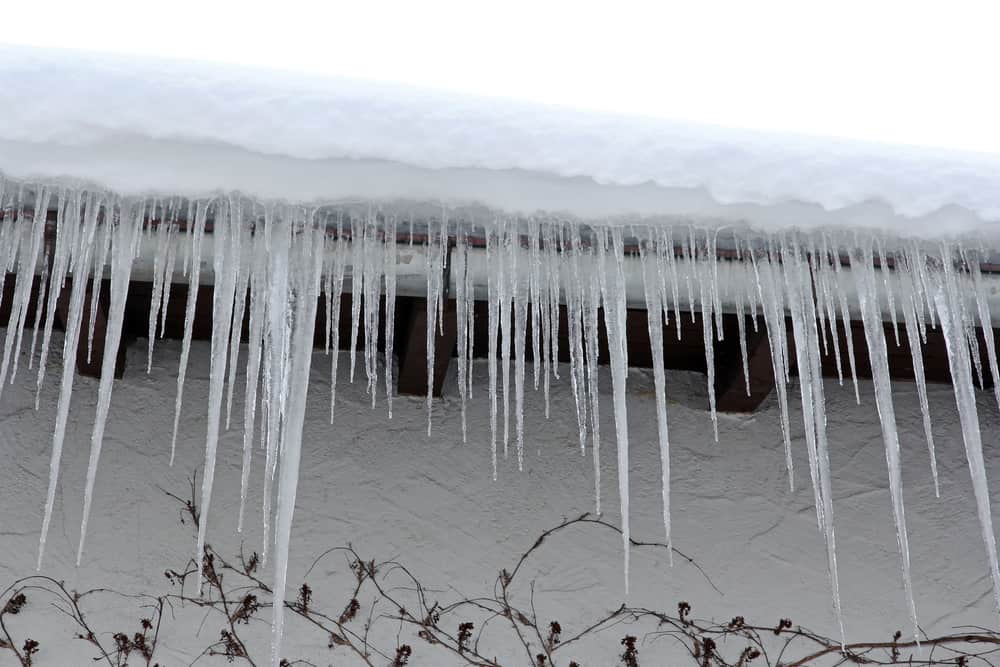

Ice dams can wreak havoc on your eaves troughs and gutters, your roof and your interior drywall if left unaddressed. While giant icicles may seem gorgeous and innocent, this winter freeze/thaw cycle can cause a host of issues. C4U Inspections in Kelowna specializes in analyzing every aspect of your building to shed insight and solutions. Protect your property by working with an experienced and friendly company who knows just what to look for.
As majestic as ice dams glisten and are admired by children; adults often see damage and future bills on their horizon. When the roof becomes warm and the bottom layer of snow begins to melt, water subsequently trickles down between the layers of snow, making its way down to the eaves. Naturally, the eves are colder as they extend beyond the warm roof and the water freezes resulting in an ice dam. Due to fluctuating temperatures during the winter months, ice dams can grow to enormous proportions. Eaves and gutters and downspouts are designed to handle water and not ice. The ice dams become heavy and can severely damage your perimeter, exterior and interior.
Water always takes the path of least resistance. The ice dam causes drainage to become blocked and the melted water may enter your home via damaged or improperly installed roof shingles and valleys along peaks. Water may infiltrate via cracked window casings or through cracks in your foundation. The end result of any long-term water damage is mold and this is extremely dangerous and detrimental to your family's health and well-being. Minimize your risk of experiencing ice dams and water seepage into your home by having C4U inspections provide you with a detailed report of the status of your residential or commercial dwelling. If you have witnessed ice dams on an annual basis, it is vital to call Lloyd and assess the damage. Prevention and maintenance are key factors for keeping your property safe, healthy and happy.
Trapped water can seep into your home through shingles and affect your insulation and drywall. In fact, water can travel as far as 5 to 10 feet back up under your shingles! Often, this issue occurs gradually over time and clients have no idea how many mold spores they are actively ingesting. This can lead to a host of respiratory diseases and allergy-like symptoms in people and their pets. If you see any water seepage or blistering paint on your walls or ceilings or rust spots on your drywall fasteners; chances are water damage is to blame. Eventually, your roof and walls will rot if left unaddressed.
You can use a mallet to carefully chip and remove existing ice blockages to clear gutters and downspouts; however, climbing ladders in the winter is not ideal. Avoid sharp objects as you will damage your roof, soffits, and eaves etc. Never use rock salt as it will damage everything including your landscaping shrubbery. A calcium chloride ice melter can be applied on top of the ice dam simply by creating a tube of material (filling pantyhose works great for this) and placing where needed. Heated plug-in "snow busters" can be beneficial and save you in the short term. The best action of course is to take the right steps to prevent ice dams from forming in the first place.
Taking a photograph of any ice dams as they form and showing C4U Inspections is always helpful to pinpoint areas of maximum concern. If you are replacing your roof, consider upgrading to a metal roof or incorporating a metal edge on the bottom of your shingle roof to dramatically improve the situation. However, if your roof is not steep enough, ice dams have been known to form on drip edges and metal roofing.
Treating the symptoms is not getting to the root of your issue: a warm roof. This occurs when insulation is not adequate and the venting isn't adequate. Keep your roof cold by sealing all locations where warm air from your home seeps into the spaces below the roof sheathing. Evaluate your insulation and add additional insulation to prevent the convection and conduction of heat loss through your ceiling. Ensure your ventilation is not being overrun by rodents or debris so that any heat leakage can be adequately removed.
Additional things to check to reduce heat loss include:
Helping you protect your investment is something C4U Inspections is passionate about. Proudly serving the Okanagan for over a decade, we are happy to assess your residential, commercial or strata development with quality home inspection services. Contact us for your home inspection today. Call (250) 212-4025